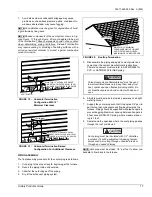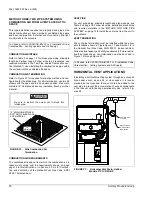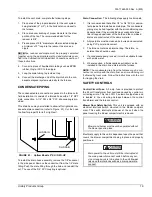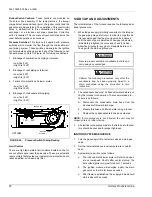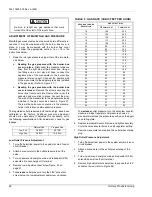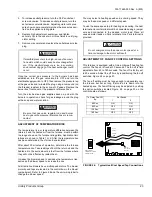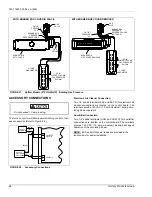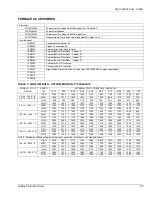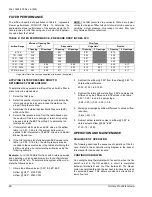
035-17480-000 Rev. A (800)
Unitary Products Group
11
COMBUSTION AIR AND VENT SYSTEM
1.
Two-pipe with a sealed combustion intake/vent system
using outdoor combustion air.
2.
Single pipe vent system using combustion air from the
area surrounding the furnace.
3.
Two-pipe intake/vent system using combustion air from a
ventilated attic space and a vent pipe to the outside.
Be sure to follow the appropriate venting section details,
related information and limitations for your type of installation.
METHOD ONE: TWO PIPE SEALED COMBUSTION
AIR & VENT SYSTEM
COMBUSTION AIR INTAKE/VENT CONNECTIONS
This type installation requires outdoor combustion air. Two
separate, properly-sized pipes must be used. One bringing
air from the outdoors to the furnace combustion air intake col-
lar on the burner box, and a second pipe from the furnace
vent connection (top right of unit) back to the outdoors. Refer
to Figure 9.
The intake/vent should be located either through the wall
(horizontal or side vent) or through the roof (vertical vent).
Care should be taken to locate side vented systems where
trees or shrubs will not block or restrict supply air from enter-
ing or combustion products from leaving the terminal.
Also, the terminal assembly should be located as far as pos-
sible from a swimming pool or a location where swimming
pool chemicals might be stored. Be sure the terminal assem-
bly follows the outdoor clearances listed in Table 2 for U.S.
installations. In Canada, refer to CAN/CGA-B149.1 or.2
Installation Code (latest edition-Venting Systems and Air
Supply).
COMBUSTION AIR/VENT PIPE SIZING
To select the proper size piping for combustion air intake and
venting, refer to Table 3. The size will be determined by a
combination of furnace model, total length of run, and the
number of elbows required. The following rules must also be
observed.Long radius elbows are required for all units.
1.
Long radius elbows are required for all units.
2.
Elbows are assumed to be 90 degrees. Two 45 degree
elbows count as one 90 degree elbow.
3.
Elbow count refers to combustion air piping and vent pip-
ing separately. For example, if the table allows for 5
elbows, this will allow a maximum of 5 elbows in the
combustion air piping and a maximum of 5 elbows in the
vent piping.
4.
Three vent terminal elbows (two for vent pipe and one for
air intake pipe) are already accounted for and should not
be counted in the allowable total indicated in the table
(see vent termination section). These parts are shown
shaded.
5.
Combustion air and vent piping must be of the same
diameter.
6.
All combustion air/vent pipe and fittings must conform to
American National Standards Institute (ANSI) standards
and American Society for Testing and Materials (ASTM)
standards D1785 (Schedule 40 PVC), D2665 (PVC-
DWV), F891 (PVC-DWV Cellular Core). D2241 (SDR-21
and SDR-26 PVC), D2261 (ABS-DWV), or F628 (Sched-
ule 40 ABS. Pipe cement and primer must conform to
ASTM Standards D2564 (PVC) or D2235 (ABS).
7.
The use of flexible connectors or no hub connectors in
the vent system is not allowed. This type connection is
allowed in the combustion air pipe near the furnace for
air conditioning coil accessibility.
This furnace is certified to be installed with one of
three possible intake/vent configurations.
Furnace Intake / Vent Connection Size (All Models)
40 - 100 MBH
120 - 140 MBH
Intake
2”
3"
Vent
2”
2"
*
*.
Vent must be increased to 3" on this model.
Note 1:Any vent pipe size change must be made out-
side furnace casing in a vertical pipe section
to allow proper drainage of condensate.
Note 2: An offset using two 45 degree elbows will be
required for plenum clearance when the vent
is increased to 3”.
FIGURE 9 :
Upflow Air Intake/vent Locations
(Models P*XU/G9D-UP)
M
P
C
1
3
2
O
F
F
O
N
OMBUSTION AIR PIPE
PASSES THROUGH TOP PANEL
CONNECTS TO COLLAR
ON TOP OF BURNER BOX
VENT PIPE
CEMENTS
INTO SOCKET JUST
UNDER TOP PANEL

















